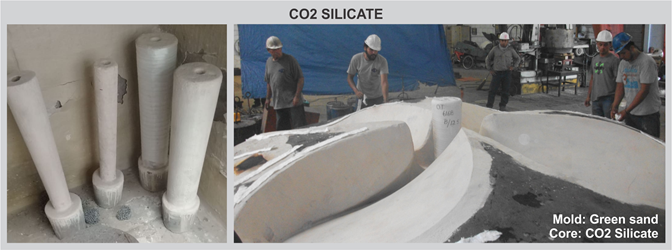|
At Rice Foundries we have the capability to use 3 different binder methods for sand molding; these are: green sand, no-bake sand and CO2 silicate sand.
GREEN SAND
Green sand is one of the first methods used to bind sand for mold making in foundry history. Silica sand is usually mixed in combination with bentonite and water. Bentonite is a
derivative of clay. To make the molds, the mixture of sand with bentonite needs to be compacted around the casting model, in such a way that the cavity with the piece is generated. It is
called "green" since this method is wet. The advantages it presents are that it is very economical, the sand can be completely reused, and it can be used for pieces of all sizes. As
disadvantages we find that the resistance of the mold is lower compared to other methods, the operators require some experience to create a uniform compaction, as it contains humidity it
favors certain casting defects related to it and it is required to use models with greater dimensional tolerances.

NO-BAKE SAND
No-bake molding is another method used at Rice Foundries. This is characterized by mixing sand with resins and catalyst, which allows the mixture to harden in a certain time. As
advantages of this method we find that it has excellent mechanical properties, the working times are controllable depending on the amount of catalyst used, so that molds can be produced
more quickly, the operators do not require as much experience in molding, the tolerances for cast iron models are small and the sand can be reused by up to 90%. As disadvantages are that
it is an expensive method compared to others, it requires certain equipment to mix and recover the sand. During molding, odors derived from resins are released, so it must be operated in
a ventilated area and when pouring the liquid metal gases are released, making it less ecological than other methods.

CO2 SILICATE
CO2 silicate molding is a cold box method, it does not require heat or compaction to harden the sand. For this method, a mixture of silica sand with sodium silicate is used, the volume
to be hardened is filled (piece or core mold) and finally a stream of CO2 is passed through, which reacts with the mixture resulting in sodium carbonate and silica gel, which
agglutinates the sand. This method is widely used especially for cores. As advantages it presents an excellent resistance, it is friendly with the environment, it offers excellent
dimensional tolerances and the price is accessible. As disadvantages we find that it is very susceptible to moisture, which causes it to lose its binding properties, for this reason the
mold or core has a short shelf life and usually, once the parts have hardened, they have to be in an oven to avoid absorbing humidity from the environment. Some experience in handling
the mixture is also required so the CO2 correctly impregnates all the parts of the mold and a uniform hardening is generated. Another disadvantage is that the sand cannot be reused for
other molds.

The following table shows a comparison of the three methods. The rating will be based on *, where more * is better for each aspect evaluated.
| |
BINDING METHOD |
| PARAMETER |
GREEN |
NO-BAKE |
SILICATE CO2 |
| Higher dimensional accuracy |
* |
*** |
** |
| Higher operating cost |
* |
*** |
** |
| Better operating speed |
* |
*** |
** |
| Greater experience required in operators |
*** |
* |
** |
| Better mechanical properties |
* |
*** |
** |
| Longer shelf life of the mold or core |
** |
*** |
* |
| More equipment needed |
** |
*** |
* |
| Environmental friendly |
* |
** |
** |
| Reuse of molding sand |
*** |
** |
* |
|